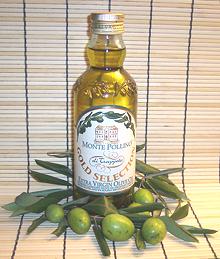 [Oleaceae]
[Oleaceae]
Here we have the king of both cooking and salad oils with a range of quality and flavors we associate with wine. The Finest olive oils do tend to come from areas famed for wine: Italy, California, Greece (OK, retsina may not be to your taste) and Spain. Turkey, Lebanon and Tunisia also makes fine olive oil, and could make good wine but for the prohibitions of Islamic law. Of these, Italy and California produce the top quality oils. Italians import huge quantities of olives from Spain and Greece, so oil labeled "Italian" isn't guaranteed made from Italian grown olives. In fact it may contain little oil of Italian manufacture at all.
When I first learned to cook, "health experts" warned us to avoid olive oil since it contained more artery clogging saturated fats than other vegetable oils. Today it's the only oil both the warring seed oil and coconut oil partisans agree is healthy, and it's the darling of both gourmets and natural foods enthusiasts. Now saturated fats are gaining favor, hydrogenated oils are the devil, and polyunsaturated vegetable oils are trying to avoid demonization.
General ConsiderationsBuying:Olive oil is best (and most economically) purchased from markets serving Mediterranean communities: Spanish, Italian, Greek, Turkish or Levantine. Trader Joe's also usually has a good selection of quality olive oils, but only in the Extra Virgin grade. They are the best local source I know for California olive oils.Select the grade appropriate to your use, Extra Virgin isn't necessarily
what you want (see below). Storing:Olive oil should be stored in a cool place and out of direct sunlight. In tightly sealed glass bottles it will keep up to a year but should be discarded after that. If stored below 50°F/10°C it will become cloudy, and if refrigerated it will become positively murky, but it will be unharmed and will clear up if allowed to rest at a warmer temperature.Grades:The grades of olive oil can be a bit confusing, but the only ones most Americans really need to deal with are Extra Virgin, Pure Olive Oil and Olive Pomace. The grades are quality grades, not flavor grades, and within any particular grade there will be wide differences of flavor depending on maker and country of origin. Grades are set by the International Olive Oil Council (IOOC) in Europe. The US is not a member of the IOOC but the only significant North American producer is California, where, for economic reasons, only Extra Virgin grade is made. The official USDA grading system predates the IOOC grades but is totally ignored even in North America.The IOOC grades are listed below, with the ones you're likely to encounter in North American markets underlined:
Important Note:"Pomace" grade olive oil is extracted using heat and solvents, and is then refined. Some so-called "experts" say this makes it unfit for human consumption - and then recommend Canola Oil produced by an even more intense process. All oils usable at high frying temperatures are refined by these same processes. Olive Oil goes through fewer steps and its unique composition makes it better able to withstand the stress. Canola oil, with it's high percentage of polyunsaturated oils, fares much worse, and others are worse than Canola. Note that "refined" olive oil (found mostly as "Pure Olive Oil") and Avocado Oil are possibly the only 400°F oils that is not solvent extracted.Usage Guidelines:
Reusing Olive OilBecause it is more durable than any other common frying oil except beef tallow, olive oil from deep frying can be reused within limits. It should be immediately strained through a plain white paper towel and stored in a sealed jar. It should not be kept long before reuse because it could have picked up less durable components from what was fried in it. If it was used for frying fish it should not be used for any other application than frying fish. Health & NutritionOlive Oils are the safest, most healthful and generally useful oils you can buy. Of course the Coconut Oil proponents would dispute that, but their Virgin Coconut Oil only goes to 350°F so it fails "generally useful". Refined Coconut oil does go to 450°F/235°C, but most Coconut Oil enthusiasts insist of Virgin. See our pages Oils and Health and Oils - Smoke Temperature & Composition for a lot more on this subject. FraudOlive oil fraud is rampant, particularly in Italy (also noted for wine made without grapes) and Spain. Usually this amounts to dying a cheap oil like sunflower greenish, but people have died in Spain from industrial grade rapeseed oil (see Canola Oil) colored with a toxic dye. Little of this crap gets to North America, but how much less serious cheating does get here is currently a mater of intense debate. What does get here is plenty of oil labeled "Italian" with little Italian content. US law requires full disclosure but the law is widely ignored. In Europe olive oil with any Italian content can be labeled "Italian". |
oi_olivez 060910 - www.clovegarden.com
©Andrew Grygus - agryg@clovegarden.com - Photos
on this page not otherwise credited © cg1
- Linking to and non-commercial use of this page permitted